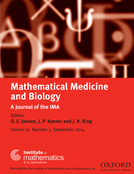-
Views
-
Cite
Cite
Balamurugan Pandiyan, Stephen J. Merrill, Salvatore Benvenga, A patient-specific model of the negative-feedback control of the hypothalamus–pituitary–thyroid (HPT) axis in autoimmune (Hashimoto's) thyroiditis, Mathematical Medicine and Biology: A Journal of the IMA, Volume 31, Issue 3, September 2014, Pages 226–258, https://doi.org/10.1093/imammb/dqt005
Close - Share Icon Share
Abstract
The purpose of modelling the negative-feedback control mechanism of the hypothalamus–pituitary–thyroid (HPT) axis in autoimmune (Hashimoto's) thyroiditis is to describe the clinical course of euthyroidism, subclinical hypothyroidism and overt hypothyroidism for patients. Thyroid hormone thyroxine (T4) and triiodothyronine (T3) levels are controlled by negative-feedback control through thyroid-stimulating hormone (TSH). T4, like other hormones, can be bound or unbound; the unbound T4 (FT4) is used as a marker for hypothyroidism. Autoimmune thyroiditis is a disease in which the thyroid-infiltrating lymphocytes attack autoantigens in follicle cells, destroying them over a long time. To describe the operation of the feedback control, we developed a mathematical model involving four clinical variables: TSH, FT4, anti-thyroid peroxidase antibodies and the thyroid gland's functional size. The first three variables are regularly measured while the last variable is determined through relationships between the other three variables. The problem of two different time scales for circulating hormones and thyroid damage is addressed using singular perturbation theory. Analysis of the mathematical model establishes stability and conditions under which the diseased state can maintain the slow movement toward diseased state equilibrium. Although we have used four variables in modelling the feedback control through the HPT axis, the predicted clinical course given any set of parameters is shown to depend on the steady-state levels of TSH and FT4. This observation makes possible the development of the clinical charts based only on the levels of TSH, time and potential steady-state values. To validate the model predictions, a dataset obtained from a Sicilian adult population has been employed.





